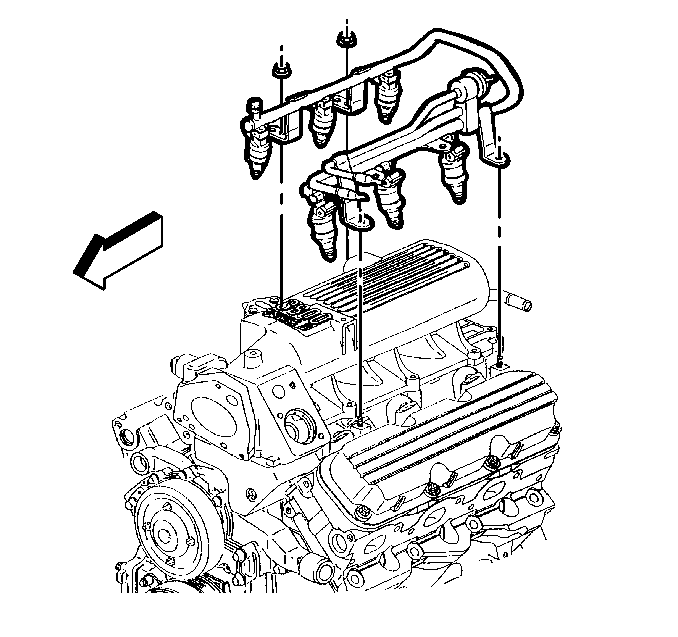Removal Procedure
- Relieve the fuel system pressure. Refer to Fuel Pressure Relief .
- Clean the fuel rail assembly and connections.
- Remove the fuel feed and fuel return pipes from the fuel rail tubes. Refer to Metal Collar Quick Connect Fitting Service .
- Remove the fuel injector coil wires.
- Remove the vacuum line from the vacuum source to the fuel pressure regulator.
- Remove the manifold absolute pressure (MAP) sensor electrical connector.
- Remove the vacuum line to the vacuum switch from the fuel pipe bundle.
- Remove the vacuum source from the intake manifold.
- Remove the fuel injector electrical connectors.
- Remove the fuel injector harness fasteners.
- Remove the fuel rail hold-down bolts.
- Remove the fuel rail with equal force on both sides of the fuel rail.
- Remove the front fuel injector retaining clips on each side of the fuel rail.
- Remove the front fuel injector on each side of the fuel rail. The fuel rail will now clear the intake manifold.

Notice: Cap the fittings and plug the holes when servicing the fuel system in order to prevent dirt and other contaminants from entering the open pipes and passages.
Important: Always maintain cleanliness when servicing fuel system components.
Installation Procedure
- The O-rings must be replaced on all components that are replaced.
- Lightly oil the fuel injector O-rings with clean engine oil.
- Without the front fuel injectors on either side of the fuel rail, place the fuel rail assembly on the intake manifold.
- Install the front fuel injector on each side of the fuel rail.
- Install the fuel injector retaining clips on the front fuel injector on each side of the fuel rail.
- Seat the fuel injectors by HAND.
- Connect the fuel injector harness fasteners.
- Connect the fuel injector electrical connectors.
- Install the vacuum source to the intake manifold.
- Install the vacuum line to the vacuum switch from the fuel pipe bundle.
- Install the vacuum line from the vacuum source to the fuel pressure regulator.
- Connect the fuel feed and fuel return pipes by pushing the pipes onto the fuel rail tubes.
- Connect the MAP sensor electrical connector.
- Connect the fuel injector coil wires.
- Reconnect the negative battery cable.
- Inspect for leaks with the following procedure:

Caution: In order to reduce the risk of fire and personal injury that may result from a fuel leak, always install the fuel injector O-rings in the proper position. If the upper and lower O-rings are different colors (black and brown), be sure to install the black O-ring in the upper position and the brown O-ring in the lower position on the fuel injector. The O-rings are the same size but are made of different materials.
Notice: Always re-attach the fuel lines and fuel filter with all original type fasteners and hardware.
Do not repair sections of fuel pipes.Notice:
• Use care when servicing the fuel system components, especially
the fuel injector electrical connectors, the fuel injector tips, and
the injector O-rings. Plug the inlet and the outlet ports of the fuel rail
in order to prevent contamination. • Do not use compressed air to clean the fuel rail assembly as this
may damage the fuel rail components. • Do not immerse the fuel rail assembly in a solvent bath in order
to prevent damage to the fuel rail assembly.
Notice: Use the correct fastener in the correct location. Replacement fasteners must be the correct part number for that application. Fasteners requiring replacement or fasteners requiring the use of thread locking compound or sealant are identified in the service procedure. Do not use paints, lubricants, or corrosion inhibitors on fasteners or fastener joint surfaces unless specified. These coatings affect fastener torque and joint clamping force and may damage the fastener. Use the correct tightening sequence and specifications when installing fasteners in order to avoid damage to parts and systems.
Tighten
Tighten the fuel rail hold-down bolts to 10 N·m (89 lb in).
Caution: Unless directed otherwise, the ignition and start switch must be in the OFF or LOCK position, and all electrical loads must be OFF before servicing any electrical component. Disconnect the negative battery cable to prevent an electrical spark should a tool or equipment come in contact with an exposed electrical terminal. Failure to follow these precautions may result in personal injury and/or damage to the vehicle or its components.
| 16.1. | Turn ON the ignition for 2 seconds. |
| 16.2. | Turn OFF the ignition for 10 seconds. |
| 16.3. | Turn ON the ignition. |
| 16.4. | Check for fuel leaks. |
